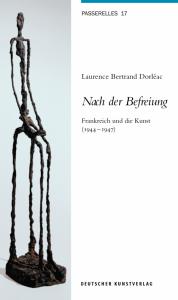Passerelles
Band 17
Laurence Bertrand Dorléac
Übersetzt von Tom Heithoff
Sprache der Publikation: Deutsch
Wie stellt sich die Kunst in Frankreich nach dem Zweiten Weltkrieg dar? Von »Rekonstruktion« wird vielfach gesprochen, aber der Begriff verschweigt die düstere Seite der Zeit und fasst nur unzureichend die Katastrophe, die sich in den Kunstwerken spiegelt. Dabei sind diese Schöpfungen oft aufrichtige Zeugnisse der Befreiung, des Holocausts, des Elends und der Bitterkeit, des Zweifels und des tiefen Traumas. Die Autorin zeigt, dass eine neue Form der Freiheit herrscht, wo die Kunst nichts mehr zu respektieren hat. Der Automatismus und Spielarten der Expressivität dominieren die künstlerische Produktion nach 1944: Sie besteht aus Exzessen und Ausbrüchen, stellt sich gegen Traditionen und reagiert auf die »schmutzigen Jahre«, wie André Pieyre de Mandiargues sie genannt hat.
Que représente l’art en France après la Seconde Guerre mondiale ? On a beaucoup parlé de « reconstruction », mais le terme occulte la part d’ombre de cette période, il est impropre à traduire le désastre si bien rendu dans les œuvres d’art. Les créations d’alors témoignent souvent au plus juste de la Libération, de la Shoah, de la misère et de l’amertume, du doute et du trauma profond. L’auteur montre à quel point ces années sont dominées par une forme étrange de liberté où l’art n’a plus à respecter quoi que ce soit. L’automatisme et l’expressivité sous toutes ses formes dominent la production artistique après 1944 : faite de débordements et d’excès, celle-ci refuse les traditions et se pose en réaction contre « les années sordides », comme les appelait André Pieyre de Mandiargues.
How did art in France represent itself after World War II? “Reconstruction” is mentioned often, but the term conceals the dark side of the times and only insufficiently touches on the catastrophe reflected in works of art. And yet these creations are often sincere testimonies to the liberation or the Holocaust; to misery and to bitterness, to doubt and to deep trauma. The author shows that a new form of freedom began to thrive where art had nothing left to respect. Automatism and various manifestations of expressiveness dominated artistic production after 1944: It consisted of excesses and outbreaks, opposed traditions and reacted to “the dirty years”, as André Pieyre de Mandiargues has called them.







